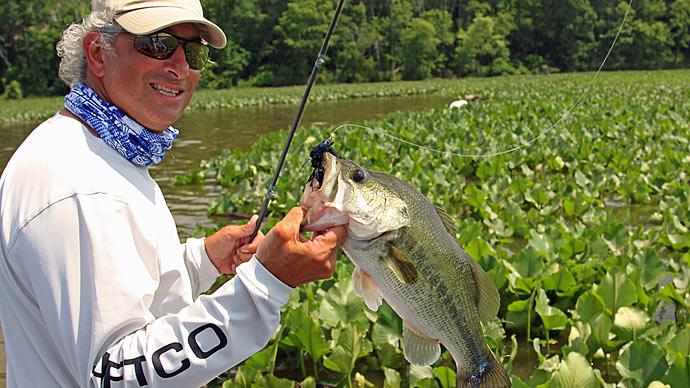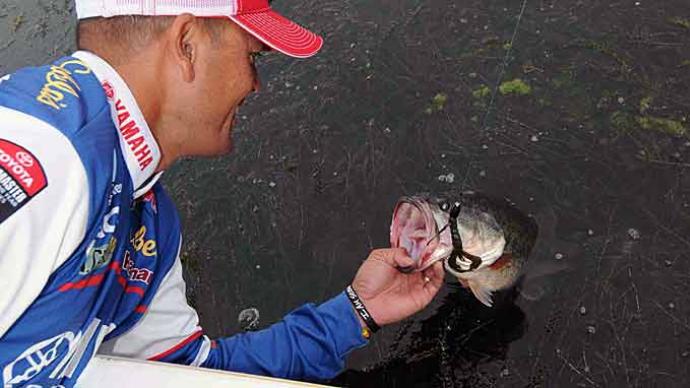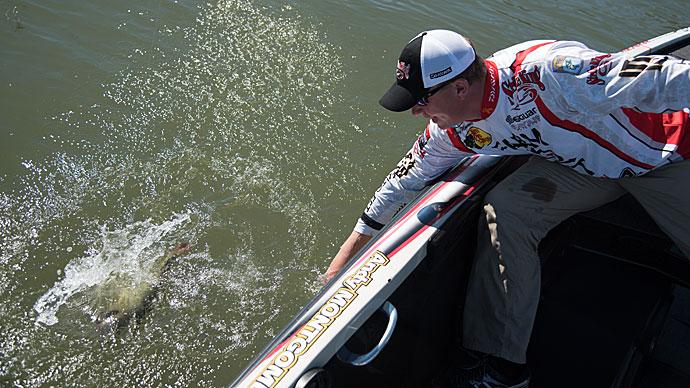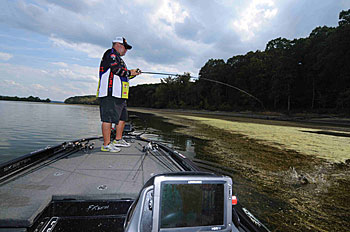
If you ever ask Bill Lowen to recall his best day of fishing in the grass, forgive him if he cannot answer that question with a particular date.
“Every day I can fish grass and catch bass is always one of my favorite days,” Lowen says.
Bass anglers know grass as any aquatic rooted plant with most vegetative mass below the water surface, although some portions may stick above the water and form into a mat. These submerged plants have flaccid or soft stems that give the vegetation a grassy appearance.
Lowen loves to fish grass because he believes the matted vegetation is ideal habitat for both bass and baitfish. “It gives bass an ambush point,” Lowen says. “The weeds are so important because they also let the baitfish (bluegill and shad) hide there. It also improves the oxygen level of the water. It is like the perfect storm when you have all those combinations.”
While grass is a blessing for a polished professional such as Lowen, the thick vegetation can be a bane to novice anglers who become frustrated when their lures get bogged down in the weeds. Lowen suggests novice anglers should start grass fishing by concentrating on the edges of weedlines with spinnerbaits and crankbaits or pitch to the holes in the grass with jigs or Texas-rigged plastic worms.
“Typically, go with weedless presentations so you can avoid getting hung up in the grass,” Lowen says. “If you are a little more advanced and want to go into the weeds, depending on how thick they are, you may have to go to a 1/2-, 3/4- or 1-ounce weight and jigs to get your bait through (the mat) or maybe fish a frog over the top of it.”
When fishing long stretches of grass, he looks for critical areas in the weeds that will hold more bass. “I try to find some type of difference in the grass, whether it would be a creek channel or ditch that runs through the grass or a depth change,” says the Bassmaster Elite Series pro, who also searches for points and pockets along the grass edges. “It’s no different than going down a bank looking for a point sticking out on the bank or something like that. It’s the same stuff you look for in that grass.”
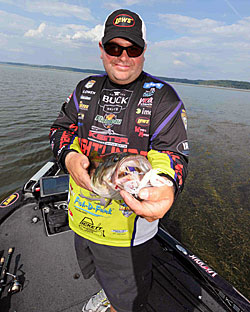
Two types of weeds growing together or a mixture of weeds and wood are critical spots for the Indiana pro to pinpoint bass in the vegetation. “Any time you can get two kinds of grass together or maybe a log lying in the grass, any kind of difference like that you can find in grass is usually a big plus,” Lowen says.
The primary grasses Lowen fishes from spring through fall are hydrilla, milfoil, and eelgrass. “Hydrilla is always good,” Lowen says of his favorite springtime grass. “Typically, the grass is just starting to grow in the spring, so it is not that thick, maybe 6 inches to 1 foot off the bottom.”
The seven-time Bassmaster Classic qualifier works springtime grass with three lures: spinnerbaits, lipless rattling crankbaits, and jigs. He slow rolls the spinnerbait, keeping it just above the submerged grass. His spinnerbait tackle consists of a 7-foot, heavy-action CastAway rod and Team Lew’s Lite Speed Spool baitcast reel (6.8:1 gear ratio) with 15-pound HI-SEAS 100 % Fluorocarbon line.
Lowen yoyos the rattle bait by lifting and dropping his 7-foot medium or medium-heavy CastAway rod, so the lure lifts up out of the weeds and then drops to the bottom. He uses the Team Lew’s LITE reel spooled with 12- to 15-pound HI-SEAS Fluorocarbon for his rattle bait presentation. The tournament veteran relies on 1/8- or 1/4-ounce jigs for working over the top of the grass with a 7-foot medium CastAway rod and Team Lew’s LITE reel filled with 15-pound test HI-SEAS Fluorocarbon.
As the grass grows taller in the summer, Lowen will change his spinnerbait presentation by speeding up his retrieve so the blade bait will stay above the weeds. He also drops weedless worms or Senkos into the grass.
When the weeds top out during the summer, Lowen either swims a jig over the tops of the weeds, skims a plastic frog over the grass mats, or punches heavyweight jigs or Texas-rigged soft plastics through the mats. Lowen depends on a 30-pound HI-Seas Grand Slam braided line with a 7-foot, 3-inch, heavy CastAway rod for swimming a jig and punching mats. He uses the same rod with a 50-pound HI-SEAS Grand Slam braid to skim frogs over the mats.
Lowen relies on a high-speed Team Lew’s LITE 7.5:1 gear ratio reel for all three grass presentations. “Once you get a bite in that grass, you can get them out of there with that high-speed reel,” Lowen says. “You can move a lot of line when you get bit in that grass. You don’t want to get out of position in that grass and get all wrapped up in that, so it is always a big plus to use that high-speed reel.”
Jig swimming and frogging in the grass continues to produce for Lowen in the fall until it gets too cold and the grass starts dying. ”It has always been a rule of thumb that dying grass is never good,” Lowen says. “The only time I like dying grass is matted stuff in the early spring. For whatever reason, that dying stuff matted up tends to draw a lot of heat, and those fish like to get under it.”
So when the grass is green, and the bass are biting, that is Lowen’s favorite day to fish.
BassResource may receive a portion of revenues if you make a purchase using a link above.


